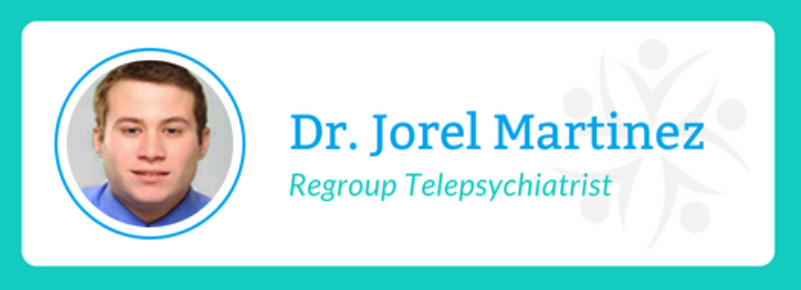
Throughout his career, Dr. Jorel Martinez has combined both his medical and cultural expertise to serve the Spanish-speaking community’s health needs. He spent time before medical school breaking down language barriers as an interpreter for the National Institutes of Health, and his bilingual abilities helped him provide the most effective care as a psychiatry resident at the University of Chicago.
Today, Martinez works as a telepsychiatrist with Regroup, serving patients at two clinics focused on providing behavioral health services to lower-income communities, Oak Street Health and Community Counseling Centers of Chicago (C4). Forty percent of the patients Martinez sees are Spanish speakers, and this bilingual and bicultural psychiatrist is just the doctor they want – and need – to see on the screen. Martinez recently answered seven questions about being a Spanish-speaking telepsychiatrist, the needs in the communities he serves and how he works to meet those needs with Regroup.
1. What attracted you to the opportunity with Regroup, and how did Regroup prepare you for this work?
What appealed to me was the patient population. There are tons of people in need of psychiatric treatment who do not have access to it. The convenience of being able to work from my home or office without having to travel also appealed to me. Regroup made sure I was well prepared for the role by teaching me how the software works and showing me little tricks of the trade, like where to look when on screen in order to make proper, natural eye contact.
2. How great is the need for psychiatric care in the Spanish-speaking community, and how does telepsychiatry help enhance access to care?
Many Spanish-speaking patients I see are the first generation here and have never seen a psychiatrist. Regroup is helping to address the need for psychiatric care by working with health centers like Oak Street and C4. One of the benefits of telepsychiatry is that it allows these facilities to offer psychiatric services in an affordable and effective way. By utilizing telepsychiatry, health centers don’t have the burden of paying a full-time psychiatrist for what may be only five hours of treating patients each week. With telepsychiatry, the centers and the psychiatrist can cast a wider net and reach more people, including those in rural areas or certain neighborhoods where Spanish-speaking people may have been underserved.
3. What are some of the cultural considerations that come into play when providing behavioral health services to the Hispanic population? As a Spanish-speaking telepsychiatrist, are you better able to address those needs?
Psychiatry, in particular, is challenging because many patients we see have racing thoughts or feel anxious or sad, and it can be difficult enough to determine what’s cause for concern, even when you’re speaking English. The language barrier adds another layer of complexity, so getting past that barrier helps tremendously. Then having an intuitive sense of what’s going on, considering their demeanor or the way they say things, understanding the challenges they face daily and the religious tie-ins, the rural living or the limited level of education… Having that shared cultural experience helps me determine what the issue may be, and then I can determine the best treatment.
4. What is a typical day like for a Spanish-speaking telepsychiatrist?
I see around 15 patients per day; some are new, and some are follow-ups. The Spanish-speaking patients I see are facing similar psychiatric conditions as the rest of the population. Some patients suffer from bipolar 1 or 2 disorder, have schizophrenia, or are dealing with substance abuse, but most have major depressive disorder. One distinguishing factor, however, is that most of my patients are very impoverished and constantly faced with major stressors in life. One out of 10 is telling me about how they’re going to get kicked out of their house. My hope is that by providing the psychiatric treatment they need, they’ll be better equipped to face these stressors.
5. Have you had a moment on the job where things haven’t gone exactly as planned? And if so, how did you handle it?
The biggest challenge is managing unexpected schedule changes if you’re working with different sites on the same day. For example, if I’m working at an Oak Street location and one patient shows up 10 minutes late, the whole schedule gets thrown off. When this happens, I just stay positive, reach out to the in-person staff and let the sites with later appointments know what the situation is.
6. What are some common misconceptions people have about your work?
A lot of people think that a telepsychiatrist is just someone you text and call, or that it’s an easier job than providing in-person care. But it’s not. It’s the same. People forget they’re on the screen. I see patients in person, too, and I don’t see much difference.
7. What’s the most fulfilling part of your work?
A lot of my patients have never seen a psychiatrist or even had access to primary care. People have been in and out of depressive episodes for years. And then I prescribe them one medication, and within a month, their lives have gotten better. I don’t do therapy in the traditional sense, but I know there are some patients for whom just seeing me makes a huge difference. And there’s a lot of gratitude for having access to a psychiatrist. People forget how depressed they were, but I see it in my notes. And when they see how their lives have changed, it’s very gratifying.
.png?width=170&height=100&name=Array_rgb%20(1).png)
